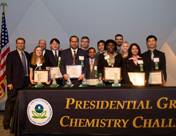Clean Chemistry
- Robert E. Maleczka, Jr.
- Professor
- Department of Chemistry
- College of Natural Science
- Milton R. Smith III
- Professor
- Department of Chemistry
- College of Natural Science

Rob Maleczka and Mitch Smith (back row, left) and their students were honored with the 2008 Presidential Green Chemistry Challenge Award.
Cutting out energy-intensive steps and producing clean byproducts from chemical reactions is what the research of Rob Maleczka and Mitch Smith is all about. It began with an informal conversation between the two chemists, who are in separate branches of the field. "Our collaboration was born out of a common interest in a class of chemical reactions known as crosscouplings," Dr. Maleczka explained. A coupling reaction describes the set of reactions when two hydrocarbon fragments are coupled with the aid of a metal-containing catalyst. In a cross-coupling, two different molecules react to form one new molecule. Their first experiments, which focused on making a certain kind of coupling called a Suzuki reaction catalytic in boron, were unsuccessful, but, as Maleczka said, "the chemistry surrounding that idea flourished."
For several years Dr. Smith and Dr. Maleczka have been investigating boronic acids (bonds between carbon and boron), which are used widely as intermediates in pharmaceutical and agrichemical research to discover new drugs and pesticides. Traditionally, byproducts of petroleum processing would first be chlorinated and then reacted with a metal, such as magnesium; finally, the resultant compound would be reacted with boron. As Smith pointed out, "Each one of these steps generates a lot of waste, and the byproducts can be toxic." He and Maleczka, on the other hand, have discovered that they can directly react the petroleum byproducts and boron with a catalyst to get the same results. "It cuts out a lot of energy-intensive steps," Smith said. "The only byproduct is hydrogen gas."
This discovery led to a number of awards, including the Presidential Green Chemistry Challenge Award in 2008. While they can't cite specific examples of how their discovery is being used commercially for confidentiality reasons—Dr. Maleczka explained that "a number of pharmaceutical companies have used the chemistry themselves, but they tend not to share the specific compounds being reacted"—they have founded the startup company, BoroPharm, located in Novi, Michigan, to manufacture and sell compounds using their process.
"It's easy to see the impact of our research, and it looks like a direct outcome of our funding—which it is—but the work with the students is the most important...students can see what research is done outside academia."
Milton R. Smith III
Certainly, Smith acknowledged, the research is significant; but he believes that the actual outcomes are less important than training students as scientists. "It's easy to see the impact of our research, and it looks like a direct outcome of our funding—which it is—but the work with the students is the most important," he said. Both undergraduate and graduate students can see what research is done outside academia. Undergraduates in the labs, for example, can see what it's like to conduct research, and from there make the decision as to whether they want to work immediately with industries or pursue a graduate education. The graduate students, meanwhile, get to perform experiments, learn how to analyze the outcomes, and use them to guide future work. In research, as Smith pointed out, "you don't know what the outcome's going to be."
Smith held up the research with borons as an example. An important piece of their breakthrough had actually been observed by another research group, who ignored it because it wasn't the information they were looking for. He also pointed out that on the surface, their discovery looked so inefficient that no one in industry would have pursued it. But in the university environment, Smith, Maleczka, and their respective teams of students were able to experiment and innovate. "It's really the students who are doing the legwork that makes discoveries possible," Smith said.
- Written by Lisa Eldrid, University Outreach and Engagement